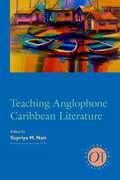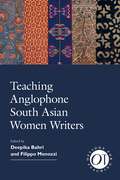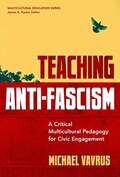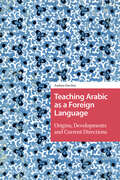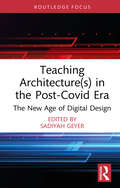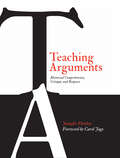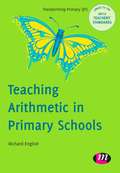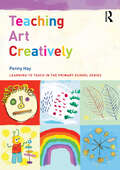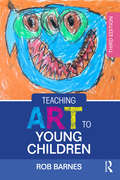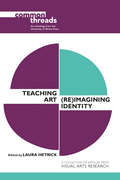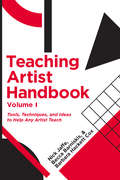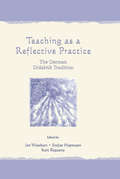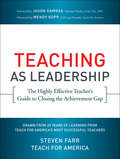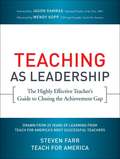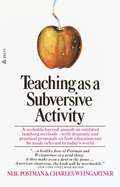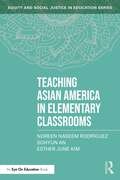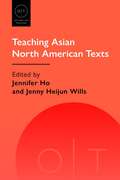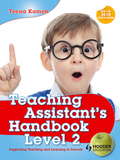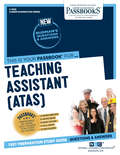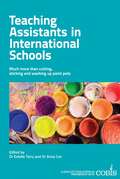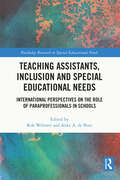- Table View
- List View
Teaching Anglophone Caribbean Literature (Options for Teaching #34)
by Grant Farred Nicole N. Aljoe Giselle Liza Anatol Albert Braz Elaine Savory John C. Hawley Elizabeth Way Alisa K. Braithwaite Jennifer P. NesbittThis volume in the Options for Teaching series recognizes that the most challenging aspect of introducing students to anglophone Caribbean literature--the sheer variety of intellectual and artistic traditions in Western and non-Western cultures that relate to it--also offers the greatest opportunities to teachers. Courses on anglophone literature in the Caribbean can consider the region's specific histories and contexts even as they explore common issues: the legacies of slavery, colonialism, and colonial education; nationalism; exile and migration; identity and hybridity; class and racial conflict; gender and sexuality; religion and ritual. While considering how the availability of materials shapes syllabi, this volume recommends print, digital, and visual resources for teaching.The essays examine a host of topics, including the following: the development of multiethnic populations in the Caribbean and the role of various creole languages in the literatureoral art forms, such as dub poetry and reggae musicthe influence of anglophone literature in the Caribbean on literary movements outside it, such as the Harlem Renaissance and black British writingCarnivalreligious rituals and beliefsspecific genres such as slave narratives and autobiographyfilm and dramathe economics of rumMany essays list resources for further reading, and the volume concludes with a section of additional teaching resources.
Teaching Anglophone South Asian Women Writers (Options for Teaching #52)
by Edited by Deepika Bahri and Filippo MenozziGlobal and cosmopolitan since the late nineteenth century, anglophone South Asian women's writing has flourished in many genres and locations, encompassing diverse works linked by issues of language, geography, history, culture, gender, and literary tradition. Whether writing in the homeland or in the diaspora, authors offer representations of social struggle and inequality while articulating possibilities for resistance.In this volume experienced instructors attend to the style and aesthetics of the texts as well as provide necessary background for students. Essays address historical and political contexts, including colonialism, partition, migration, ecological concerns, and evolving gender roles, and consider both traditional and contemporary genres such as graphic novels, chick lit, and Instapoetry. Presenting ideas for courses in Asian studies, women's studies, postcolonial literature, and world literature, this book asks broadly what it means to study anglophone South Asian women's writing in the United States, in Asia, and around the world.
Teaching Anti-fascism: A Critical Multicultural Pedagogy For Civic Engagement (Multicultural Education Ser.)
by James A. Banks Michael VavrusThis timely book examines how fascist ideology has taken hold among certain segments of American society and how this can be addressed in curriculum and instruction. Vavrus presents middle, secondary, and college educators and their students with a conceptual framework for enacting a critical multicultural pedagogy by analyzing discriminatory discourse and recommending civic anti-fascist steps people can take right now. For teacher education programs and policymakers, anti-fascist civic assessment rubrics are provided. To help clarify contemporary debates over what can be taught in public schools, an advance organizer highlights contested and misunderstood terminology. Featuring historical and contemporary patterns of fascist politics, this accessible text is organized in four parts: “Good Trouble,” Unpacking Ideological Orientations, Indicators of Colonial Proto-Fascism and U.S. Fascist Politics, and An Anti-Fascist “Reading the World.” Readers will come away with a deeper knowledge base that marshalls a century of anti-fascist actions in response to contemporary acts of racism, anti-Semitism, Islamophobia, gender and sexuality discrimination, bias against Latinx and migrant populations, and other actions that undermine our democracy and harm marginalized students and their families and communities. Book Features: A groundbreaking framework for incorporating anti-fascist pedagogical concepts into multicultural education Descriptions of common characteristics of historical fascism, far-right extremism, and anti-fascism. Anti-fascist assessment rubrics for teacher educators. Guidance to assist classroom teachers in contextualizing current anti-democracy events. Recommended and annotated anti-fascist background readings informed by critical, theoretical, and intersectional perspectives.
Teaching Arabic as a Foreign Language: Origins, Developments and Current Directions
by Andrea FacchinTeaching Arabic as a Foreign Language concentrates on the origins, developments and current directions of the discipline Teaching Arabic as a Foreign Language (TAFL) within the Arab world and partially outside of it during the last 60 years, namely between 1958 and 2018. Considered in this volume are the most influential scholars, authors, educators and those significant works that have contributed to the development of the discipline. In addition, special attention is paid to the TAFL institutes, regarded as epicenters of TAFL activities and important meetings, that allow scholars to gather around the same table and discuss approaches, trends and methods used in the field. All of these aspects converge in one comprehensive study which is enriched by a narration of the main sociopolitical changes that have affected the Middle East in latter-day history.
Teaching Architecture: The New Age of Digital Design (Routledge Focus on Design Pedagogy)
by Sadiyah GeyerIn the post-COVID era, understanding the profound impact of digital technologies on design pedagogy is crucial. This book delves into experimental design education, showcasing projects utilising technology to transform creative and analytical processes.Emphasising the potential for digital-era technologies to create novel educational opportunities, the book addresses recent global events and their role in minimising educational disruptions in the evolving hybrid educational landscape. Each chapter offers case studies exploring digital technology's influence across architectural education, spanning interior design, urban planning, parametric digital design, architectural conservation, and design analysis. Contributors envision the hybrid virtual design studio’s future and discuss the collaborative role of digital technologies in urban design projects. The book analyses contemporary parametric design processes and machine learning through innovative historical case studies, examining new technologies in architectural conservation.With case studies from diverse locations, including South Africa, Turkey, the UK, and the United States, the book provides a global perspective on the influences and potential futures of digital technologies in architecture. Essential for those interested in the future of spatial design education, this book illuminates the pivotal role of technology in shaping its trajectory.
Teaching Arguments: Rhetorical Comprehension, Critique, and Response
by Jennifer FletcherNo matter wherestudents' lives lead after graduation, one of the most essential tools we can teach them is how to comprehend, analyze, and respond to arguments. Students need to know how writers' and speakers' choices are shaped by elements of the rhetorical situation, including audience, occasion, and purpose. In Teaching Arguments: Rhetorical Comprehension, Critique, and Response , Jennifer Fletcher provides teachers with engaging classroom activities, writing prompts, graphic organizers, and student samples to help students at all levels read, write, listen, speak, and think rhetorically.Fletcher believes that, with appropriate scaffolding and encouragement, all students can learn a rhetorical approach to argument and gain access to rigorous academic content. Teaching Arguments opens the door and helps them pay closer attention to the acts of meaning around them, to notice persuasive strategies that might not be apparent at first glance. When we analyze and develop arguments, we have to consider more than just the printed words on the page. We have to evaluate multiple perspectives; the tension between belief and doubt; the interplay of reason, character, and emotion; the dynamics of occasion, audience, and purpose; and how our own identities shape what we read and write. Rhetoric teaches us how to do these things.Teaching Arguments will help students learn to move beyond a superficial response to texts so they can analyze and craft sophisticated, persuasive arguments-;a major cornerstone for being not just college-and career-ready but ready for the challenges of the world.
Teaching Arguments: Rhetorical Comprehension, Critique, and Response
by Jennifer FletcherNo matter wherestudents' lives lead after graduation, one of the most essential tools we can teach them is how to comprehend, analyze, and respond to arguments. Students need to know how writers' and speakers' choices are shaped by elements of the rhetorical situation, including audience, occasion, and purpose. In Teaching Arguments: Rhetorical Comprehension, Critique, and Response, Jennifer Fletcher provides teachers with engaging classroom activities, writing prompts, graphic organizers, and student samples to help students at all levels read, write, listen, speak, and think rhetorically.Fletcher believes that, with appropriate scaffolding and encouragement, all students can learn a rhetorical approach to argument and gain access to rigorous academic content. Teaching Arguments opens the door and helps them pay closer attention to the acts of meaning around them, to notice persuasive strategies that might not be apparent at first glance. When we analyze and develop arguments, we have to consider more than just the printed words on the page. We have to evaluate multiple perspectives; the tension between belief and doubt; the interplay of reason, character, and emotion; the dynamics of occasion, audience, and purpose; and how our own identities shape what we read and write. Rhetoric teaches us how to do these things.Teaching Arguments will help students learn to move beyond a superficial response to texts so they can analyze and craft sophisticated, persuasive arguments - a major cornerstone for being not just college-and career-ready but ready for the challenges of the world.
Teaching Arithmetic in Primary Schools: Audit and Test (Transforming Primary QTS Series)
by Mr Richard EnglishThere is a new and increasing emphasis on the importance of teaching arithmetical skills in primary schools. This text outlines what is meant by arithmetic and enables trainee teachers to build their own confidence in teaching arithmetic. It covers all aspects of arithmetic including recall of number facts and traditional pen and paper methods. Each arithmetical approach is illustrated with detailed examples and readers can access their own learning in each area. Guidance on when and where to use different approaches to enhance children's learning is included and interactive activities highlight essential links between theory and practice. Abouth the Transforming Primary QTS series This series reflects the new creative way schools are begining to teach, taking a fresh approach to supporting trainees as they work towards primary QTS. Titles provide fully up to date resources focused on teaching a more integrated and inclusive curriculum, and texts to draw out meaningful and explicit cross curricular links.
Teaching Art & Design in the Primary School
by Gloria Callaway Abigail Leach Mary KearFirst Published in 1999. Routledge is an imprint of Taylor & Francis, an informa company.
Teaching Art Creatively (Learning to Teach in the Primary School Series)
by Penny HayTeaching Art Creatively is packed with ideas and inspiration to enrich teachers' knowledge and understanding of art and design in the primary classroom. It synthesises the philosophical and practical elements of teaching, encouraging a move away from traditional didactic approaches to contemporary classroom pedagogies to develop children’s creative potential. With an emphasis on recognising the value of children’s art and how to support children’s creative and artistic processes, key topics explored include improving your own creativity, competence and confidence helping children become independent artists starting points and imaginative contexts for art and design individual, group and whole class work art inside and outside the classroom how to develop visual literacy the value of working alongside artists the contribution of art and design to children’s overall creative development Teaching Art Creatively offers a new model of visual arts education in the primary years. Illustrated throughout with examples of exciting projects, children’s work and case studies of good practice, it will be essential reading for every professional who wishes to embed creative approaches to teaching in their classroom.
Teaching Art to Young Children
by Rob BarnesHow can teachers develop best practice in art teaching? This fully updated third edition of Rob Barnes’ classic text blends practical ideas with sound principles of art education. Teachers and student teachers will find a range of ideas and tried and tested classroom examples; whilst for those looking for firm principles of art teaching and ‘best practice’ this book presents many important issues in art education with clarity and insight. Based on first-hand experience of teaching children, this text uses many examples from early years and primary school contexts, and tackles essential topics with realism and imagination such as: developing skills through using media how children draw encouraging artistic confidence in children producing original artwork and making use of digital imagery Rob Barnes’ unique approach encourages teachers to develop and think about art as part of a rich curriculum of learning, highlighting how it shouldn’t be taught in isolation but with purposeful links to other areas of the curriculum.
Teaching Art: (Re)Imagining Identity (Common Threads)
by Laura HetrickA student's personal identity constantly changes as part of the lifelong human process to become someone who matters. Art educators in grades K-16 have a singular opportunity to guide important phases of this development. How can educators create a supportive space for young people to work through the personal and cultural factors influencing their journey? <P><P>Laura Hetrick draws on articles from the archives of Visual Arts Research to approach the question. Juxtaposing the scholarship in new ways, she illuminates methods that allow educators to help students explore identity through artmaking; to reinforce identity in positive ways; and to enhance marginalized identities. <P><P>A final section offers suggestions on how educators can use each essay to engage with students who are imagining, and reimagining, their identities in the classroom and beyond. Contributors: D. Ambush, M. S. Bae, J. C. Castro, K. Cosier, C. Faucher, K. Freedman, F. Hernandez, L. Hetrick, K. Jenkins, E. Katter, M. Lalonde, L. Lampela, D. Pariser, A. Pérez Miles, M., and K. Schuler. Laura Hetrick is an assistant professor of art education at the University of Illinois, Urbana-Champaign, and the coeditor of the journal Visual Arts Research.
Teaching Artist Handbook, Volume One: Tools, Techniques, And Ideas To Help Any Artist Teach
by Nick Jaffe Barbara Hackett Cox Rebecca BarniskisTeaching Artist Handbook is based on the premise that teaching artists have the unique ability to engage students as fellow artists. In their schools and communities, teaching artists put high quality art-making at the center of their practice and open doors to powerful learning across disciplines. This book is a collection of essays, stories, lists, examples, dialogues, and ideas, all offered with the aim of helping artists create and implement effective teaching based on their own expertise and strengths. The Handbook addresses three core questions: “What will I teach?” “How will I teach it?” and “How will I know if my teaching is working?” It also recognizes that teaching is a dynamic process that requires critical reflection and thoughtful adjustment in order to foster a supportive artistic environment. Instead of offering rigid formulas, this book is centered on practice―the actual doing and making of teaching artist work. Experience-based and full of heart, the Teaching Artist Handbook will encourage artists of every experience level to create an original and innovative practice that inspires students and the artist.
Teaching Artist Handbook: Tools, Techniques and Ideas to Help any Artist Teach
by Nick Jaffe Becca Barniskis Barbara Hackett Cox"Teaching Artist Handbook" is based on the premise that teaching artists have the unique ability to engage students as fellow artists. In their schools and communities, teaching artists put high quality art-making at the center of their practice and open doors to powerful learning across disciplines. This book is a collection of essays, stories, lists, examples, dialogues, and ideas, all offered with the aim of helping artists create and implement effective teaching based on their own expertise and strengths. The "Handbook" addresses three core questions: "What will I teach?" "How will I teach it?" and "How will I know if my teaching is working?" It also recognizes that teaching is a dynamic process that requires critical reflection and thoughtful adjustment in order to foster a supportive artistic environment. Instead of offering rigid formulas, this book is centered on practice--the actual doing and making of teaching artist work. Experience-based and full of heart, the "Teaching Artist Handbook" will encourage artists of every experience level to create an original and innovative practice that inspires students and the artist.
Teaching As A Reflective Practice: The German Didaktik Tradition (Studies in Curriculum Theory Series)
by Ian Westbury Stefan Hopmann Kurt RiquartsThis volume presents a mix of translations of classical and modern papers from the German Didaktik tradition, newly prepared essays by German scholars and practitioners writing from within the tradition, and interpretive essays by U.S. scholars. It brings this tradition, which virtually dominated German curricular thought and teacher education until the 1960s when American curriculum theory entered Germany--and which is now experiencing a renaissance--to the English-speaking world, where it has been essentially unknown. The intent is to capture in one volume the core (at least) of the tradition of Didaktik and to communicate its potential relevance to English-language curricularists and teacher educators. It introduces a theoretical tradition which, although very different in almost every respect from those we know, offers a set of approaches that suggest ways of thinking about problems of reflection on curricular and teaching praxis (the core focus of the tradition) which the editors believe are accessible to North American readers--with appropriate "translation." These ways of thinking and related praxis are very relevant to notions such as reflective teaching and the discourse on teachers as professionals. By raising the possibility that the "new" tradition of Didaktik can be highly suggestive for thinking through issues related to a number of central ideas within contemporary discourse--and for exploring the implications of these ideas for both teacher education and for a curriculum theory appropriate to these new contexts for theorizing, this book opens up a gold mine of theoretical and practical possibilities.
Teaching As Leadership
by Steven Farr Jason Kamras Wendy Kopp Teach For AmericaA road map for teachers who strive to be highly effective leaders in our nation's classroomsTeach For America has fought the daunting battle of educational equity for the last twenty years. Based on evidence from classrooms across the country, they've discovered much about effective teaching practice, and distilled these findings into the six principles presented in this book. The Teaching As Leadership framework inspires teachers to: Set Big Goals; Invest Students and Their Families; Plan Purposefully; Execute Effectively; Continuously Increase Effectiveness; Work Relentlessly. The results are better educational outcomes for our nation's children, particularly those who live in low-income communities.Inspires educators to be leaders in their classrooms and schoolsDemystifies what it means to be an effective teacher, describes key elements of practice and provides a clear vision of successAddresses the challenges every teacher, in every classroom, faces on a daily basisAn accompanying website includes a wealth of tools, videos, sample lessons, discussion boards, and case studies.
Teaching As Leadership: The Highly Effective Teacher’s Guide to Closing the Achievement Gap
by Teach for America Staff Steven Farr Jason Kamras Wendy KoppA road map for teachers who strive to be highly effective leaders in our nation's classrooms Teach For America has fought the daunting battle of educational equity for the last twenty years. Based on evidence from classrooms across the country, they've discovered much about effective teaching practice, and distilled these findings into the six principles presented in this book. The Teaching As Leadership framework inspires teachers to: Set Big Goals; Invest Students and Their Families; Plan Purposefully; Execute Effectively; Continuously Increase Effectiveness; Work Relentlessly. The results are better educational outcomes for our nation's children, particularly those who live in low-income communities. Inspires educators to be leaders in their classrooms and schools Demystifies what it means to be an effective teacher, describes key elements of practice and provides a clear vision of success Addresses the challenges every teacher, in every classroom, faces on a daily basis An accompanying website includes a wealth of tools, videos, sample lessons, discussion boards, and case studies.
Teaching As a Subversive Activity: A No-Holds-Barred Assault on Outdated Teaching Methods-with Dramatic and Practical Proposals on How Education Can Be Made Relevant to Today's World
by Neil PostmanA no-holds-barred assault on outdated teaching methods--with dramatic and practical proposals on how education can be made relevant to today's world.From the Trade Paperback edition.
Teaching Asian America in Elementary Classrooms (Equity and Social Justice in Education Series)
by Noreen Naseem Rodríguez Soyhun An Esther June KimAsian American voices and experiences are largely absent from elementary curricula. Asian Americans are an extraordinarily diverse group of people, yet are often viewed through stereotypical lenses: as Chinese or Japanese only, as recent immigrants who do not speak English, as exotic foreigners, or as a “model minority” who do well in school. This fundamental misperception of who Asian Americans are begins with young learners―often from what they learn, or do not learn, in school. This book sets out to amend the superficial treatment of Asian American histories in U.S. textbooks and curriculum by providing elementary teachers with a more nuanced, thematically driven account. In chapters focusing on the complexity of Asian American identity, major moments in Asian immigration, war and displacement, issues of citizenship, and Asian American activism, the authors include suggestions across content areas for guided class discussions, ideas for broader units, and recommendations for children’s literature as well as primary sources.
Teaching Asian North American Texts (Options for Teaching #57)
by Jennifer Ho and Jenny Heijun WillsFrom the short stories and journalism of Sui Sin Far to Maxine Hong Kingston's pathbreaking The Woman Warrior to recent popular and critical successes such as Viet Thanh Nguyen's The Sympathizer, Mohsin Hamid's The Reluctant Fundamentalist, and Kevin Kwan's Crazy Rich Asians, Asian North American literature and media encompass a long history and a diverse variety of genres and aesthetic approaches.The essays in this volume provide context for understanding the history of Asian immigrants to the United States and Canada and the experiences of their children, grandchildren, and great-grandchildren. Contributors address historical contexts, from the early enactment of Asian exclusion laws to the xenophobia following 9/11, and provide tools for textual analysis. The essays explore conventionally literary texts, genres such as mystery and speculative fiction, historical documents and legal texts, and visual media including films, photography, and graphic novels, emphasizing the ways that creators have crossed boundaries of genre and produced innovative new forms.
Teaching Assistant's Handbook for Level 2: Supporting Teaching and Learning in Schools
by Teena KamenThis textbook will be the perfect companion to you if you are taking a qualification in Supporting Teaching and Learning in Schools at level 2, whether that is the Award in Support Work in Schools, Certificate in Supporting Teaching and Learning in Schools, or Certificate in Supporting the Wider Curriculum.Teaching Assistant's Handbook for Level 2, offers you a comprehensive and practical guide to supporting the development of children and young people in a variety of educational settings, including primary, secondary and special schools as well as extended schools. The tasks included will develop your personal and professional skill as well as key tasks which will contribute to your assesment.This new edition in updated in line with the revisions made to the specification following the implementation of the Qualifications and Curriculum Framework in 2010, and now mirrors the structure of the units that make up the various Level 2 qualifications.
Teaching Assistant: Passbooks Study Guide (Career Examination Series #C-2845)
by National Learning CorporationThe Teaching Assistant Passbook® prepares you for your test by allowing you to take practice exams in the subjects you need to study. It provides hundreds of questions and answers in the areas that will likely be covered on your upcoming exam, including but not limited to: reading comprehension; writing skills, including grammar, usage and vocabulary; mathematics; and more.
Teaching Assistants in International Schools: More than cutting, sticking and washing up paint pots!
by Anna Cox Estelle TarryWhere would a classroom be without a really great TA? Ask any teacher and they will tell you that the classroom just wouldn't be the same without them. However, a great teaching assistant requires training. This book, published in partnership with the Council of British International Schools, helps demonstrate how TAs can be effective in the classroom and make a real difference to learning.
Teaching Assistants in International Schools: More than cutting, sticking and washing up paint pots!
by Anna Cox Estelle TarryWhere would a classroom be without a really great TA? Ask any teacher and they will tell you that the classroom just wouldn't be the same without them. However, a great teaching assistant requires training. This book, published in partnership with the Council of British International Schools, helps demonstrate how TAs can be effective in the classroom and make a real difference to learning.
Teaching Assistants, Inclusion and Special Educational Needs: International Perspectives on the Role of Paraprofessionals in Schools (Routledge Research in Special Educational Needs)
by Rob Webster Anke A. de BoerThis book offers the first collection of international academic writing on the topic of Teaching Assistants. It serves as an indicative summary of current research and thinking in this field and as a point of departure for future research and development. With contributions from leading researchers, the book draws together empirical work on the deployment and impact of Teaching Assistants from various perspectives and from a range of methodological approaches. It highlights and celebrates the vital everyday contributions Teaching Assistants make to their schools and their communities: from their role within classrooms, to their moment-by-moment interactions with pupils and teachers. The book examines the effect that Teaching Assistants can have on pupils’ learning and wellbeing, and considers issues of overdependence on classroom paraprofessionals and the unintended consequences to which this can lead. Bringing together work from a journal special issue with brand new and updated chapters, the contributions offer insight into the liminal space between educator, care-giver, behaviour manager, and facilitator of learning and of peer relations, which characterises the Teaching Assistant role. This timely and important book will be essential reading for academics, researchers and students interested in special educational needs, disability, and inclusion, and those interested in the wider topic of paraprofessionals in labour markets.
